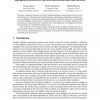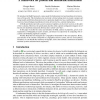34 search results - page 6 / 7 » membrane 2009 |
CORR
2009
Springer
13 years 6 months ago
2009
Springer
mework can be used to compare and merge models at different abstraction levels; in particular, higher-level (e.g. mobility) activities can be given a formal biological justificatio...
ISBI
2009
IEEE
14 years 3 months ago
2009
IEEE
Membrane-bound protein, expressed in the basal-lateral region, is heterogeneous and an important endpoint for understanding biological processes. At the optical resolution, membra...
CIBCB
2009
IEEE
13 years 9 months ago
2009
IEEE
Tools for the identification of trans-membrane spans from the protein sequence are widely used in the experimental community. Computational structural biology seeks to increase the...
CORR
2009
Springer
13 years 6 months ago
2009
Springer
dels at different abstraction levels; in particular, higher-level (e.g. membrane) activities can be given a formal biological justification in terms of low-level (i.e., protein) in...
MEMBRANE
2009
Springer
14 years 3 months ago
2009
Springer
evel of abstraction that we adopt, the functioning of a biochemical reaction is based on facilitation and inhibition: a reaction can take place if all of its reactants are present ...


